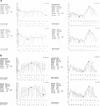Electrophysiological examination in uveitis: a review of the literature
- PMID: 24453476
- PMCID: PMC3894140
- DOI: 10.2147/OPTH.S54838
Electrophysiological examination in uveitis: a review of the literature
Abstract
Purpose: Uveitis is the inflammation of the uveal tract, which usually also affects the retina and vitreous humor. The electrophysiological examination is an objective ocular examination that includes the electroretinogram, visual evoked potentials, the electrooculogram, the multifocal electroretinogram, and multifocal visual evoked potentials. Our aim is to review the literature of the use of the electrophysiological examination in cases of uveitis.
Methods: We performed a systematic search of the literature of published papers until October 2012 using the PubMed search engine. The key terms that were used were "uveitis", "electrophysiological examination", "electroretinogram", "visual evoked potentials", "electrooculogram", "multifocal electroretinogram", and "multifocal visual evoked potentials" in multiple combinations. To the best of our knowledge, this is the first review concerning the assessment of electrophysiology in uveitis.
Results: Our search of the literature demonstrated that the electrophysiological examination, mainly by means of electroretinogram, multifocal electroretinogram, and visual evoked potentials, is performed in several cases of uveitis for many purposes, including diagnosis and monitoring of disease progression and treatment efficacy. The electrophysiological examination is more useful in patients with multiple evanescent white dot syndrome, acute posterior multifocal placoid pigment epitheliopathy, birdshot chorioretinopathy, Vogt-Koyanagi-Harada disease, Adamantiades-Behçet disease, ocular syphilis, and Fuchs heterochromic cyclitis.
Conclusion: This review summarizes the use of the electrophysiological examination in uveitic patients and underlines its value as a useful tool in the objective assessment and the monitoring of the disease.
Keywords: ERG; VEP; mfERG; uveitis.
Figures






Similar articles
-
Application of Ophthalmic Electrophysiology in Inflammatory Disorders of Retina and Optic Nerve.J Clin Med. 2024 Jun 29;13(13):3829. doi: 10.3390/jcm13133829. J Clin Med. 2024. PMID: 38999396 Free PMC article. Review.
-
Multi-modal imaging and anatomic classification of the white dot syndromes.Int J Retina Vitreous. 2017 Mar 20;3:12. doi: 10.1186/s40942-017-0069-8. eCollection 2017. Int J Retina Vitreous. 2017. PMID: 28331634 Free PMC article. Review.
-
Visual evoked potential (VEP) and multifocal electroretinogram (mfERG) in ocular syphilitic posterior segment inflammation.Doc Ophthalmol. 2012 Oct;125(2):169-78. doi: 10.1007/s10633-012-9339-9. Epub 2012 Jun 23. Doc Ophthalmol. 2012. PMID: 22729668
-
Challenges in posterior uveitis-tips and tricks for the retina specialist.J Ophthalmic Inflamm Infect. 2023 Aug 17;13(1):35. doi: 10.1186/s12348-023-00342-5. J Ophthalmic Inflamm Infect. 2023. PMID: 37589912 Free PMC article. Review.
-
[The value of electroretinography in uveitis].Ophtalmologie. 1990 Mar-Apr;4(2):169-72. Ophtalmologie. 1990. PMID: 2235010 French.
Cited by
-
Efficacy and Safety Evaluation of Mometasone Furoate in Treating Ocular Inflammation.Pharmaceutics. 2023 Jan 5;15(1):193. doi: 10.3390/pharmaceutics15010193. Pharmaceutics. 2023. PMID: 36678822 Free PMC article.
-
Visual Electrodiagnostic Testing in Birdshot Chorioretinopathy.J Ophthalmol. 2015;2015:680215. doi: 10.1155/2015/680215. Epub 2015 Jul 13. J Ophthalmol. 2015. PMID: 26246903 Free PMC article. Review.
-
Birdshot chorioretinopathy: current knowledge and new concepts in pathophysiology, diagnosis, monitoring and treatment.Orphanet J Rare Dis. 2016 May 12;11(1):61. doi: 10.1186/s13023-016-0429-8. Orphanet J Rare Dis. 2016. PMID: 27175923 Free PMC article. Review.
-
Pearls and pitfalls of optical coherence tomography angiography in the multimodal evaluation of uveitis.J Ophthalmic Inflamm Infect. 2017 Oct 5;7(1):20. doi: 10.1186/s12348-017-0138-z. J Ophthalmic Inflamm Infect. 2017. PMID: 28983872 Free PMC article. Review.
-
Advances in sciatic nerve regeneration: A review of contemporary techniques.Regen Ther. 2025 May 6;29:563-574. doi: 10.1016/j.reth.2025.04.016. eCollection 2025 Jun. Regen Ther. 2025. PMID: 40475697 Free PMC article. Review.
References
-
- Bloch-Michel Ea, Nussenblatt RB. International uveitis study group recommendations for the evaluation of intraocular inflammatory disease. Am J Ophthalmol. 1987;103:234–235. - PubMed
-
- Wakefield D, Chang JH. Epidemiology of uveitis. Int Ophthalmol Clin. 2005;45:1–13. - PubMed
-
- Bodaghi B, Cassoux N, Wechsler B, et al. Chronic severe uveitis: etiology and visual outcome in 927 patients from a single center. Medicine Baltimore. 2001;80:262–270. - PubMed
Publication types
LinkOut - more resources
Full Text Sources
Other Literature Sources

